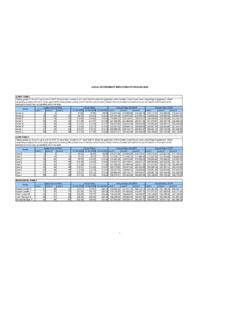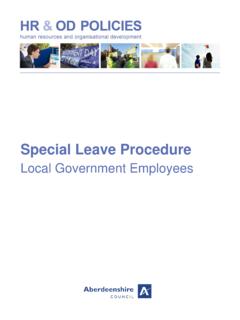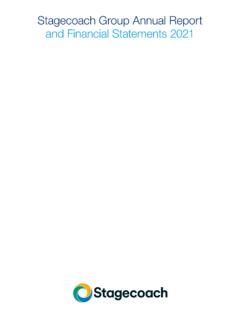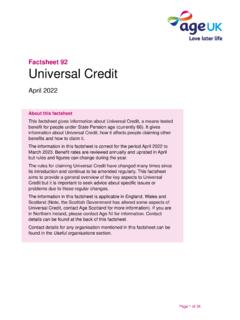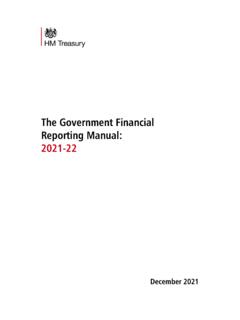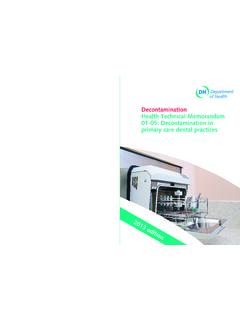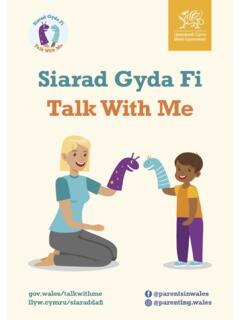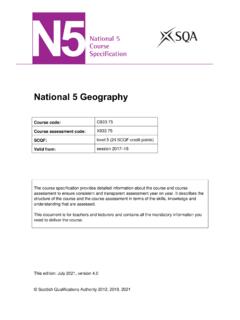Transcription of From mountain to sea COVID-19 (Coronavirus ... - …
1 1 From mountain to sea COVID-19 (Coronavirus): Guidance and Information for Managers and Employees Living with COVID -19 .. 2 Test and Protect .. 2 Recording of COVID Related Absence .. 3 Health & Wellbeing .. 5 Vaccination .. 5 Distance Aware Scheme .. 6 Long COVID Support .. 6 Annual Leave .. 6 Travel & Subsistence ..6 7 04 August 2022 2 Living with COVID -19 From March 2022 most of the remaining legal requirements for Coronavirus regulations were removed, specifically the: requirement to collect and share visitor information requirement to have regard to Scottish Government guidance about minimising risk of exposure to coronavirus on its premises requirement to take reasonably practicable measures, as set out in the guidance, to minimise incidence and spread of coronavirus Key changes made from the 18 April 2022 included.
2 Wearing of face coverings become guidance on public transport and in indoor settings such as workplaces or shops. The request for everyone to regularly test if they have no symptoms will end. (Council facilitated community testing will end in line with this.) The remaining requirement to wear face coverings in schools (where they still exist) are to be moved to guidance. Test and Protect Most people no longer need to take a coronavirus test and should follow the Stay at Home guidance if unwell. Testing is still available to specific groups. Free lateral flow devices (LFDs) for the purposes of twice weekly routine testing are no longer available for the general population given the changing advice, but will continue to be free for any purpose for which testing continues to be advised for clinical care, for health and social care workers and for people visiting vulnerable individuals in care homes or hospitals You can order free tests if.
3 You work in the NHS health or social care settings you have a health condition which means you re eligible for new coronavirus treatments you're going into hospital for surgery or a procedure you're visiting a hospital or care home you're an unpaid carer you're applying for the self-isolation support grant Health and Social Care staff, who are eligible, will continue with twice weekly asymptomatic LFD testing. Test results should be reported on the NSS testing portal. Health and Social Care staff who work with patients and service users in a face-to face setting, who have symptoms of a respiratory infection and a high temperature or do not feel well enough to attend work, are advised to take a lateral flow device (LFD) test as soon as they feel unwell.
4 The result of the LFD test should be reported to their line 3 manager. If the LFD test result is negative, they can attend work if they are clinically well enough to do so and they do not have a high temperature. Further specific guidance and advice for HSCP staff can be found here. Symptoms Public Health advice for people who feel unwell, have symptoms of a respiratory infection such as coronavirus and have a high temperature or do not feel well enough to go to work or carry out normal activities is Stay at Home and avoid contact with other people to reduce the risk of infecting others.
5 Symptoms of coronavirus, flu and common respiratory infections include: continuous cough high temperature, fever or chills loss of, or change in, your normal sense of taste or smell shortness of breath unexplained tiredness, lack of energy muscle aches or pains that are not due to exercise not wanting to eat or not feeling hungry headache that's unusual or longer lasting than usual sore throat, stuffy or runny nose diarrhoea feeling sick or being sick Recording of COVID Related Absence Employees who are affected by COVID, but continue to work from home.
6 Should log hours as normal and maintain contact with line manager. All COVID-19 absences where the employee is unfit to work or is unable to work from home should be recorded as sickness absence for the reason of Covid . Where an employee is currently on Paid Special Leave (PSL) due to Covid, if their absence extends beyond 1 July 2022 the PSL period should be ended and their continuing absence recorded through the normal sickness absence procedure as Covid via askHR/ People Manager. The manager should also advise the employee of the change in status of their absence.
7 NHS Isolation Notes When an employee is affected by COVID and remains unfit to work after 7 days of self-certification an NHS isolation note will be required to be submitted covering the period from the first day of illness to day 10 of the absence or a GP s certificate from day 8 4 until fit to return to work. All absence extending beyond 10 days will require to be covered by a GP s certificate. There is an exception to this, for front line Health & Social Care employees required to undertake regular testing for Covid, as part of their role. When testing positive, these employee absences should be recorded as paid special leave (PSL) for up to a maximum of 10 calendar days.
8 For these specific employees in the Health & Social Care Partnership: Record absence as Covid Self isolating (Unable to WFH) PSL via People Manager /Paid Special Leave Form. Close PSL leave period once recovered, minimum of stay at home for 5 days to maximum 10 days. After day 10 and still unwell, close the PSL period and record the continuing absence through the normal sickness absence procedure as Covid via askHR / People Manager. The Council also has a legal duty to report any cases where an employee has been diagnosed with COVID-19 that may be work related. Covid 19 cases need only be recorded in the Corporate Accident and incident reporting database where there has been incidental exposure to the virus.
9 An example of incidental exposure would include providing care for a resident of a care home who is known to have COVID-19 . It does not include cases were COVID-19 is potentially Example: On 1st August, John is feeling unwell with Covid-related symptoms and is unable to work from home. He remains unwell up until 15th August and returns to work on 16th August. Timescales & Actions Required Period Recording of Sickness Absence 1st to 7th August John s period of absence is covered by self-certification 8th to 10th August John should obtain (i) an isolation note with a start date of 1st August covering the period up to 10th August or (ii) a Fit Note from their GP and submit this to his line manager.
10 Note: the line manager should forward the isolation note/fit note to Payroll. 10th to 15th August John should obtain a Fit Note from his GP for this period of absence and submit this to his line manager. Note: the line manager should forward the fit note to Payroll On his return to work on 16th August, John should input his absence end date of 15th August into ESS to end and self-certify his absence, or this can be done on his behalf by his line manager or relevant administrative staff. 5 transmitted through general transmission within the workplace either from another employee or a member of the public.
